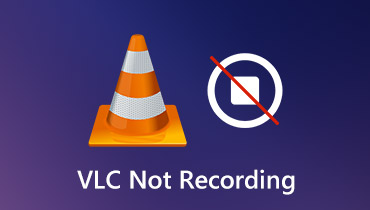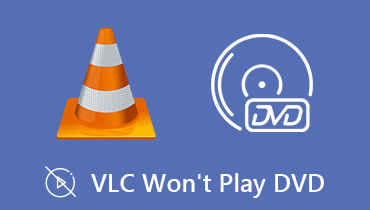8 Simple Processes to Solve the VLC Black Screen Efficiently
VLC's black screen is one of the issues you might encounter when using the media player to watch videos. This problem can dissatisfy and frustrate viewers. So, if you are looking for the best solution to fix the issue, then there is a reason for you to read this guidepost. We are here to assist you in achieving your goal for better video playback. Aside from that, we will also include some of the possible reasons why there's a black screen on VLC Media Player. Without anything else, come here and get to know more about the topic.

PAGE CONTENT
Part 1. Reason Why VLC Black Screen Happens
This type of video playback issue can happen for various reasons. The details below will give you some insights into why the black screen occurs.
Corrupted Video Files
There are times when the video itself is the problem. If you have a corrupted or damaged video file, then you cannot play the video on your media player. Corrupted files can happen due to incomplete downloads, damaged storage devices, transfer errors, or malware attacks. Always ensure that your video file is in good condition to have an effective video playback.
Incorrect Video Output Settings
The VLC Media Player can change the video display on your screen. However, there are times when the output settings are incompatible with your graphics display or card, which can lead to a black screen issue. So, if you have modified the settings before, the best thing to do is to turn them back to default.
Hardware Acceleration Issue
Hardware acceleration allows VLC Media Player to leverage your computer's GPU for smoother video playback. However, since not all devices support this feature properly, compatibility issues with your drivers or graphics card may result in a black screen. Toggling this setting on or off could resolve the problem.
Outdated Media Player
If your video is in good condition and still encounters an issue, then maybe your media player is the problem. If you are using an outdated VLC Media Player, then various issues might appear, including a black screen. Using outdated software can't give you excellent performance. Also, it can't deal with media files with the latest codecs. It would be best to use the media player with its latest or up-to-date version for smoother video playback.
Part 2. Best Way to Solve the VLC Black Screen Issue
After learning all the possible reasons why you can't play your video or why your media player has a black screen, you may wonder how to solve the problem. If so, you can read all the solutions here to solve the problem effectively.
Solution 1. Fix VLC Black Screen Using Vidmore Videdon Fix
If your video file is damaged, unplayable, or corrupted, you might encounter a problem. If you want to repair your video, you must use exceptional software capable of fixing it. Now, if you have no idea what tool to utilize, we would like to introduce Vidmore Video Fix. This is among the most reliable video repair programs you can trust when it comes to fixing the video. It can repair your video in many ways. It can fix the resolution, missing codecs, bitrate, sample rate, and more. In addition to that, it can produce a satisfying video quality, allowing you to watch the content satisfyingly. The good thing here is that the software can provide its AI-powered technology. This feature is perfect if you want to fix the video without encountering any problems. You can even insert a video, no matter the format. You can attach MP4, MOV, FLV, AVI, WMV, MKV, M4V, and more. Therefore, if you need a professional-grade video repair software, there is no doubt that Vidmore Video Fix is the one you need.
More Features
● Its AI-driven technology is available for a smoother repair procedure.
● The software can offer an intuitive UI perfect for all users.
● It can deal with numerous output video formats.
● It has the Preview feature to check the video's condition.
● It is accessible to Mac and Windows.
If you want to repair your corrupted or damaged video file, you can follow the simple tutorial below to achieve your desired result.
Step 1. Download Vidmore Video Fix on your computer. You can access it on your Mac and Windows.
Step 2. From the main layout, you can begin attaching your corrupted file by hitting Red + from the left interface. Use the Blue + to insert a sample video.
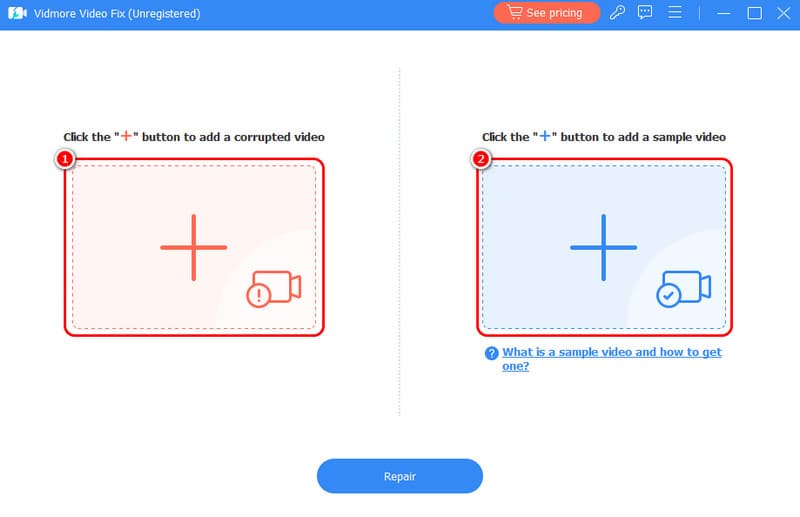
Step 3. After that, you can start ticking the Repair button to start repairing the corrupted video file.
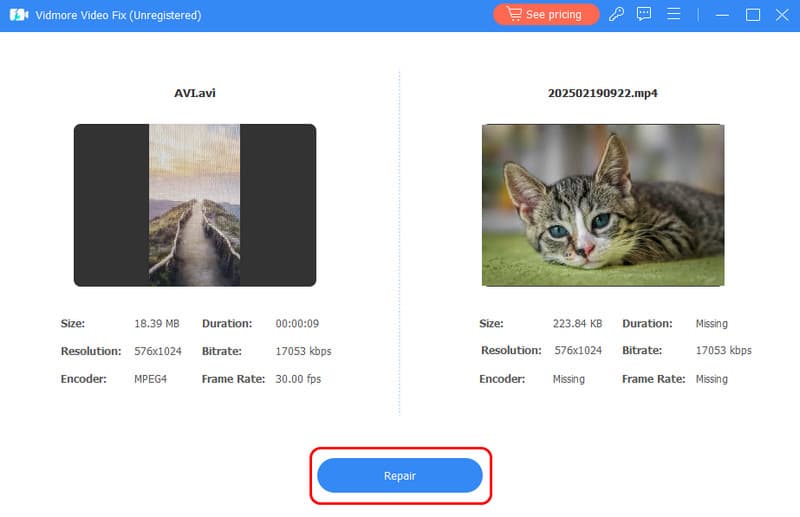
Once the repair process finishes, you can click the Preview feature to check the condition of the video.
Step 4. If you have already checked the video, you can hit/tick the Save button to save the repair video file to your computer.
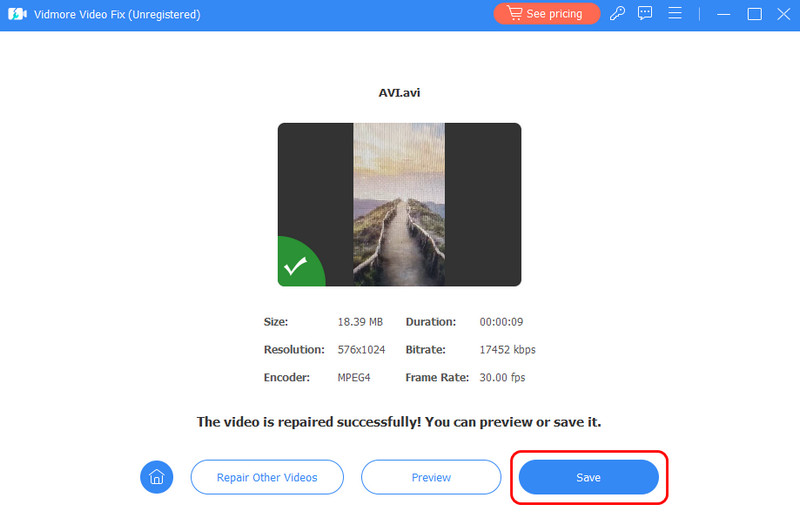
After learning this instruction, you can now fix your video without encountering any hassle. This software allows you to fix videos easily and effectively. The best part is that it can even repair various video playback issues. It can fix lagging video in VLC, shaky video, pixelated video, blurry video, and more.
Solution 2. Try to Play/Open Another Video File

If you are unsure about the main reason why your video has a black screen, you can try playing another video file. If the video plays smoothly, it only means that the previous video files are the problem. On the other hand, if the same issue occurs, it may have something to do with your media player. To open another video file, all you need to do is proceed to the Media section and choose the Open File option. When your computer folder shows up, browse the video file you want to open.
Solution 3. Disable VLC Hardware Acceleration

Hardware acceleration can help you play your videos smoothly. However, there are also times when it is the main reason for some errors. With that in mind, it would be best to turn off or disable the hardware acceleration on VLC. To begin the process, launch VLC and proceed to the Tools > Preferences feature. Then, go to the Input/Codecs section and find the Hardware-accelerated decoding option. Select the Disable option and hit Save to apply changes to your settings.
Solution 4. Fix VLC Black Screen by Using the VLC Repair Feature
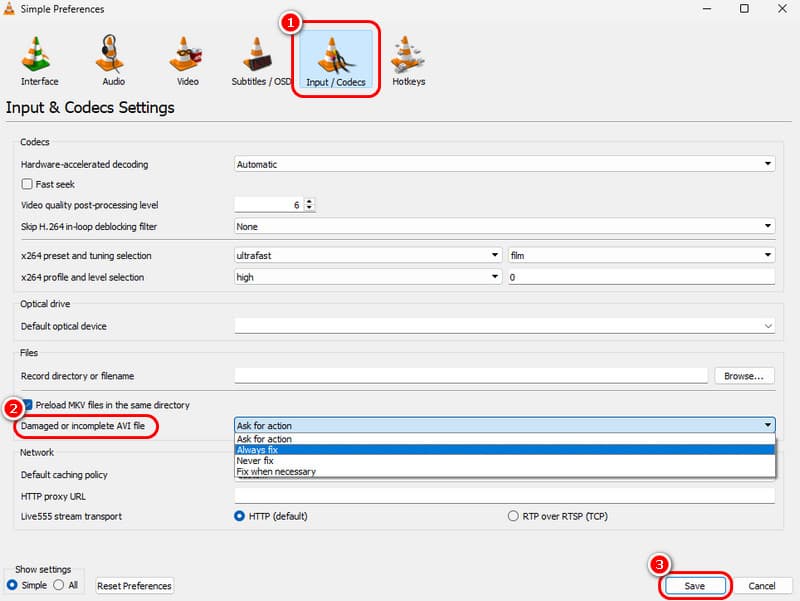
Do you want to fix the issue effectively? In that case, the best thing to do is to use VLC Media Player's repair feature. With this feature, you can repair the video file, especially AVI, without any problem. It can even give you a smooth video playback, allowing you to have a nice experience. It can also fix VLC audio delay, making the process more ideal. With that, to start the process, you can open the VLC player and proceed to the Tools > Preferences section. After that, go to the Input/Codecs option and proceed to the Damaged or Incomplete AVI files section. Choose the Always Fix option and hit Save to apply changes.
Solution 5. Update VLC to Fix the VLC Black Screen
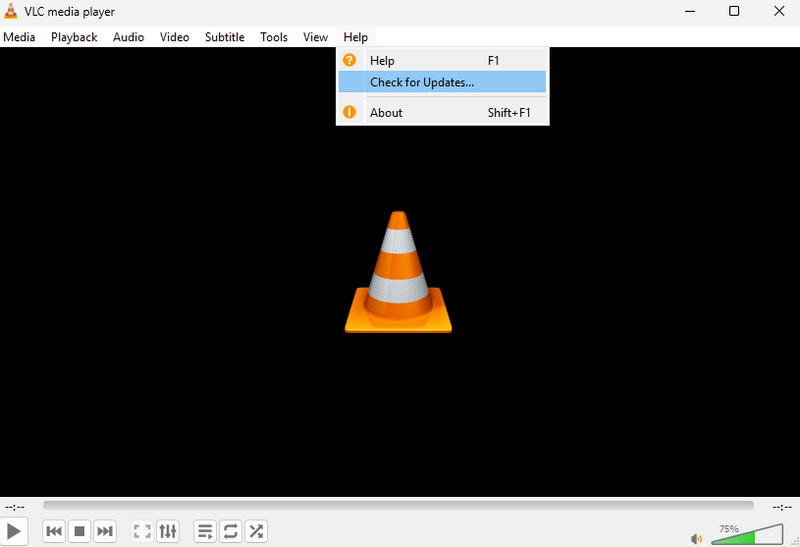
Do you want to fix the VLC MP4 black screen issue? Then, you can try updating your media player. As we have mentioned, an outdated program can result in errors. The best thing to do is to get the media player's latest version. With that, you can deal with various media files, no matter if they have the newest codecs. To update VLC, you have to run it on your device and click the Help menu. After that, tick the Check for updates option. Once done, you can check the instructions on your screen to install the software's newest version.
Solution 6. Adjust Video Output Settings to Solve the VLC Black Screen
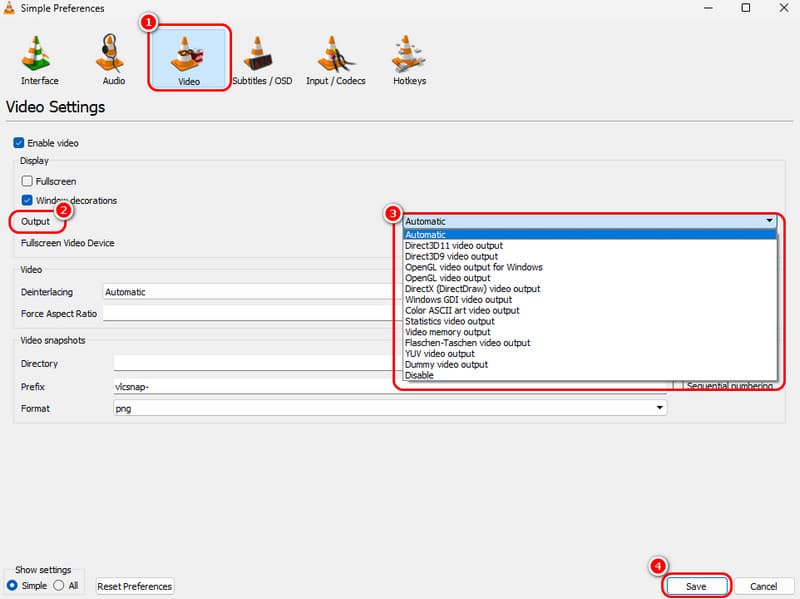
Another way to solve the issue is to change the video output settings on VLC. An incompatible output module can lead to video playback issues. If you can't play your video file, it would be best to try other output modes. Some of them are YUV Video Output, Direct3D11, OpenGL Video Output, and more. To start the process, proceed to the Tools > Preferences > Video section. After that, go to the Output and choose your preferred output mode. Once done, click the Save button. You can also use this method to fix the VLC MKV black screen issue.
Solution 7. Reset VLC Preferences
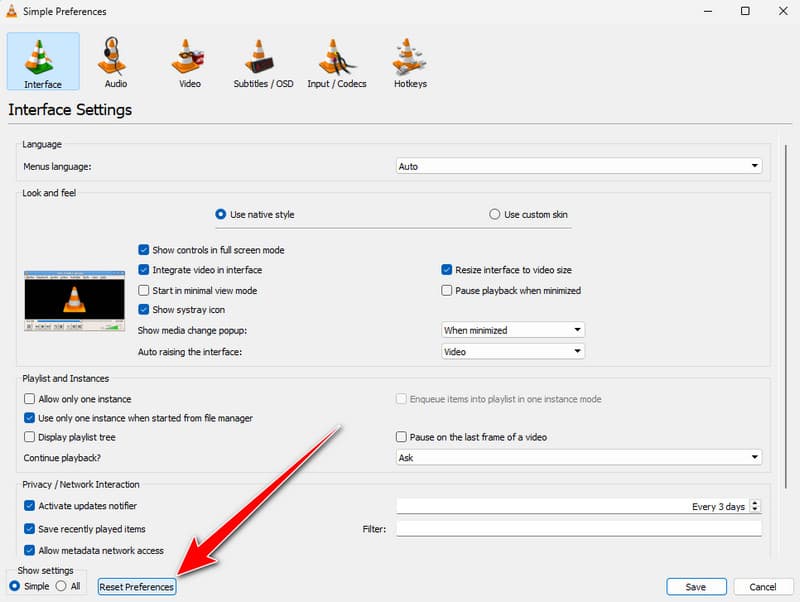
If you hear audio from a VLC black-screen video, you may have altered some settings in the media player. In that case, the most effective solution is to reset the VLC preferences. This way, you can reset everything to default. To start the process, open VLC and navigate to the Tools > Preferences selection. After that, go to the bottom interface and hit the Reset Preferences button. Once done, you can now try opening your video file.
Solution 8. Check if the VLC Codecs are Enough
Missing or unsupported codecs might cause VLC's black screen problem. Since video file formats constantly evolve, VLC may not always have built-in support for the latest ones. You can expand its compatibility by installing additional codecs, allowing the player to handle a wider variety of media files.
Conclusion
Thanks to this informative post, you have learned how to fix the VLC black screen issue. Follow all the instructions in this article to obtain your desired result. Plus, if you prefer using exceptional software to repair your video for effective playback, it would be best to access Vidmore Video Fix. With this program, you can fix almost all video playback errors/issues quickly and smoothly.

